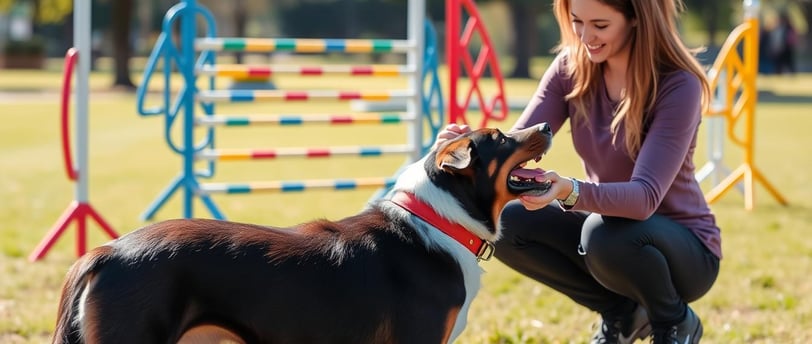Stop Your Dog's Barking: place command for dogs
Discover quick and effective strategies to stop your dog's excessive barking with place command for dogs. Learn practical techniques and tools to manage and reduce unwanted barking behavior.
The Canine Chronicles
8/31/202410 min read


Are you tired of your dog's constant barking?
It can be both frustrating and disrupt your peace.
But, there are ways to help your dog stop barking and bring calm back to your home.
Learn about dog barking solutions that can change everything.
They help you understand why your dog barks and how to use training to stop dog barking.
Key Takeaways
Understand the different types of dog barking, including territorial, alarm, and attention-seeking.
Learn how to ignore barking for attention and teach your dog alternative behaviors, such as the "quiet" command.
Manage environmental triggers by blocking views and limiting greetings at the door.
Utilize the "place" command and seek professional help from trainers and behaviorists if needed.
Prevent boredom and provide ample exercise to reduce excessive barking triggers.
Understand Why Your Dog Barks
Before you can stop your dog's barking, it's key to know why they bark. Dogs bark for many reasons, like to defend their territory, alert you to danger, or seek attention. Knowing what makes your dog bark will help you pick the best training methods.
Territorial Barking
Dogs bark to protect their territory, like their home or favorite spot. This happens when they see new people, animals, or things they don't like. They're trying to say, "This is mine, stay away!"
Alarm Barking
When your dog sees or hears something strange or scary, they might bark to warn you. This alarm barking is a natural way to keep your family safe. Figuring out what makes them bark can help you stop it.
Attention-Seeking Barking
Some dogs bark just to get your attention. They might want food, playtime, or a walk. This attention-seeking barking is something they've learned works. You need a special plan to stop this kind of barking.
Knowing why your dog barks helps you find the right way to stop it. This makes your home quieter and more peaceful.
Ignore Barking for Attention
Ignoring your dog's barking is a great way to stop it. Dogs often bark to get your attention, and reacting by yelling or showing affection makes it worse. Instead, ignore attention-seeking barks by turning your back or walking away. This shows your dog that barking is an ineffective way to get your attention.
To ignore your dog's barking well, be consistent. When your dog barks for attention, don't scold or give in. Instead, calmly move away and redirect your dog's behavior by doing something else, like training or playing. This method will teach your dog that barking doesn't work to get your attention.
"The key is to completely ignore the barking, without any verbal or physical interaction. This sends a clear message that barking won't get the desired response."
Also, don't reward your dog with attention or treats when they're calm. Instead, praise, pet, or give them a favorite treat for being quiet. This positive feedback will help your dog look for your attention in better ways.



Remember, consistently ignoring attention-seeking barking and focusing on positive activities is best. With patience and consistency, you can teach your dog that barking isn't the way to get what they want.
Teach Your Dog Alternative Behaviors
Instead of just ignoring your dog's barking, teach them new actions that get your attention. Actions like sitting quietly or looking at you can work well. Training a "quiet" command is also helpful, rewarding your dog for stopping their bark. Obedience training can also help your dog control their barking.
Quiet on Cue
Teaching your dog the "quiet" command is great for handling too much barking. Begin by using clicker training to link the word "quiet" with stopping their bark. Give them a treat and praise when they stop barking, which encourages calmness.
Impulse Control
Improving your dog's impulse control can also help reduce barking.
Teach your dog to "wait" or "stay" before rewarding them, gradually increasing the duration to build self-control.
Obedience training exercises like "leave it" and "drop it" can reinforce your dog's ability to resist impulses.
By teaching your dog new behaviors and improving their impulse control, you can manage their barking better. This makes for a calmer, more obedient pet.
"The key to reducing barking is to teach your dog alternative behaviors that earn your attention and reinforcement."
Manage Environmental Triggers
To stop your dog from barking, manage the things that make them bark. This means blocking what they see and stopping them from saying hello to visitors. This helps create a calm, quiet zone for them.
Block Views Out the Window
If your dog barks at people walking by, close the curtains or blinds. This blocks their view and cuts down on their territorial and alarm barking. It helps them not be upset by things outside.
Prevent Greeting at the Door
Always greet visitors before letting your dog near the door. Or, use baby gates to stop your dog from saying hello at the door. This way, you can control the things that make them bark.
Make a "quiet zone" in your home where your dog can go to feel safe.
Think about using calming things, like pheromone diffusers or calming music, in their quiet space.
"The key to managing environmental triggers is to proactively eliminate or minimize the stimuli that can spark your dog's barking behavior."
By doing these things, you can block what they see, stop them from greeting at the door, and make a quiet zone. This helps you manage the barking triggers that make your dog bark too much.
Dog Barking Solutions: Train "Place" Command
Tackling your dog's barking issues can be tough, but training the "place" command is a great solution. This method not only shifts your dog's focus but also gives them a safe spot to relax.
The "place" command makes your dog go to a certain spot, like a bed or mat, and stay calm. This spot becomes a place of relaxation and positive vibes for them. It helps manage their barking and channels their energy into better activities.
Begin training the "place" command in a quiet area. Give treats and praise when they go to their spot and stay calm.
After they learn the command, try it in tricky situations like when someone knocks on the door or sees a pedestrian.
Keep reinforcing the "place" command by rewarding them for staying calm in their spot. This makes the behavior stronger and more natural for your dog.
By training the "place" command and creating a safe space, you can redirect your dog's attention and control their barking. This keeps your home peaceful and strengthens your bond with your dog.
"The 'place' command is a game-changer for managing dog barking. It provides a structured and rewarding way to redirect your pup's energy and keep them calm in triggering situations."
Seek Professional Help
If you've tried many ways and your dog still barks a lot, it's time to get help from a pro. Certified dog trainers and animal behaviorists can give you advice tailored to your dog. They use methods like desensitization and counterconditioning to tackle the real reasons behind your dog's barking.
Certified Trainers and Behaviorists
Working with dog trainers and animal behaviorists is a great step towards solving your dog's barking problems. They know how to find out what makes your dog bark and create a plan using positive reinforcement.
Tools like Spray Collars
Spray collars can help reduce barking, but use them with a pro's guidance. Using them wrong can hurt your dog. So, it's key to work with a certified trainer or behaviorist to use these devices safely and effectively.
Remember, fixing your dog's barking takes time, consistency, and understanding what your dog needs. With the help of trained experts, you can make a plan that tackles the real cause of the problem. This way, your dog can learn better behaviors.
"The key to success in addressing dog barking is to work closely with certified professionals who can provide personalized guidance and employ the latest, most effective training techniques."
Prevent Boredom and Exercise
A bored or under-exercised dog may bark too much. Giving your dog enough physical and mental activity can lower this risk. There are many ways to keep your dog busy and active. This helps prevent boredom and gives them a place to use their energy.
It's important to exercise your dog every day. You can do this by walking them, playing fetch, or training them. Providing mental stimulation with toys, puzzle feeders, or new commands also helps. This stops boredom and bad behavior.
Take your dog on a daily walk or jog to meet their physical activity needs.
Play interactive games like fetch or tug-of-war to keep them mentally engaged.
Introduce puzzle toys or feed your dog using a slow-feeder bowl to challenge their problem-solving skills.
Enroll your dog in training classes or practice obedience commands at home to provide mental stimulation.
By giving your dog enough daily exercise and mental stimulation, you can stop boredom. This also lowers the chance of too much barking or bad behavior. A happy, well-exercised dog is a great companion.
"A tired dog is a good dog. Keeping your pup physically and mentally active is crucial for their overall well-being and behavior."
Use Desensitization Techniques
Fixing the reasons behind your dog's barking is crucial. Desensitization training is a strong method. It involves slowly exposing your dog to things that make them bark, like people or animals. Pairing this with positive reinforcement helps them become less reactive and bark less.
Desensitization means slowly introducing your dog to the things that make them bark in a safe space. You give them treats or praise when they stay calm. This teaches them to see the trigger as something good, not just a reason to bark.
Counterconditioning is another good approach. It teaches your dog a new behavior, like sitting or lying down, when they see the barking trigger. Giving them positive reinforcement for this new behavior helps them forget about barking and see the trigger in a better way.
Remember, consistency and patience are important. Slowly expose your dog to the things that make them bark and reward calmness. With time, your dog will learn to stay calm and make your home quieter.


"Desensitization and counterconditioning are powerful tools for reducing barking in dogs. With time and patience, you can help your canine companion learn to remain calm in the face of their triggers."
Teach "Quiet" Command
Teaching your dog a "quiet" command can help stop their barking. By rewarding your dog for remaining silent, they learn to link quiet with good things. This helps them bark less over time.
Using operant conditioning, a method that rewards good actions, is key. Here's how to start:
Give treats or praise when your dog is quiet. This makes them want to stay quiet more.
After your dog knows quiet gets rewards, say "quiet" before they bark. They'll connect the word with being quiet.
Try the "quiet" command in different places, asking for longer quiet times for treats. This makes the training stronger and more dependable.
Being consistent and patient is crucial when teaching the "quiet" command. With regular reward-based training, your dog will stop barking when told to. This gives you a powerful way to handle their barking.
"Quiet training is a game-changer for dog owners dealing with excessive barking. It puts you in control and helps your furry friend learn to self-soothe."
Conclusion
To stop your dog from barking too much, you need to look at the main reasons and teach them new behaviors. Use the tips in this article, like ignoring attention-seeking barks and managing what triggers them. Also, make sure they get enough exercise and mental activities.
This summary gives you long-term ways to keep your home quiet. Remember, being consistent and patient is important when dealing with your dog's barking. With hard work and positive training, you can stop the unwanted barking and have a better relationship with your dog.
The methods talked about here help you make your home calmer and more peaceful for you and your dog. Keep an eye on what makes your dog bark and fix those issues. This way, you can get lasting results and have a quieter, happier home.
FAQ
Why do dogs bark excessively?
Dogs bark for many reasons, like to protect their territory, alert others, or seek attention. Knowing what makes your dog bark helps you pick the best way to stop it.
How can I stop my dog from barking for attention?
Don't give in to your dog's barks by yelling or showing them affection. Instead, ignore these barks by walking away. This shows your dog that barking doesn't work to get your attention.
What can I do to manage environmental triggers that cause my dog to bark?
To reduce your dog's barking, close curtains to block their view or use baby gates near the front door. Creating a quiet area for your dog can also help.
How can I teach my dog the "place" command?
Teach your dog the "place" command by having them go to a specific spot, like a bed or mat, and stay calm. This keeps them away from things that make them bark and gives them a safe place to relax.
When should I seek the help of a professional dog trainer?
If your dog still barks a lot after trying different methods, get help from a pro. Certified trainers and behaviorists can give you tailored advice and use techniques like desensitization and counterconditioning.
How can I prevent boredom and provide enough exercise for my dog?
Make sure your dog gets enough exercise and mental activity to prevent barking. This can be done by walking them, playing fetch, or doing training exercises together.
What is desensitization, and how can it help stop my dog's barking?
Desensitization helps your dog by slowly getting them used to things that make them bark. By doing this with positive rewards, your dog will become less reactive and bark less.
How can I teach my dog the "quiet" command?
Teaching your dog the "quiet" command can help stop them from barking on command. Reward them for being quiet to teach them that being silent is good. This can make them bark less over time.
Source Links
Further reading
https://thek9chronicles.com/complete-guide-to-puppy-training
https://thek9chronicles.com/mental-health-dogs
Thanks and best regards
The Canine Chronicles.
Click here for a healthy canine!
Disclaimer: This post may contain affiliate links. We may earn a commission from qualifying purchases at no extra cost to you. We only recommend products we've personally used and trust. Your support helps us maintain this site. Thank you.
Disclaimer: The information provided is for educational purposes only and is not intended to diagnose, treat, cure, or prevent any disease. Always consult with a qualified healthcare professional before starting any supplement regimen or making changes to your pets health routine.
